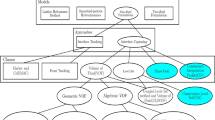Abstract
We present an accurate and efficient explicit hybrid solver for Maxwell's equations in time domain. The hybrid solver combines FD-TD with an unstructured finite volume solver. The finite volume solver is a generalization of FD-TD to unstructured grids and it uses a third-order staggered Adams–Bashforth scheme for time discretization. A spatial filter of Laplace type is used by the finite volume solver to enable long simulations without suffering from late time instability problems. The numerical examples demonstrate that the hybrid solver is superior to stand-alone FD-TD in terms of accuracy and efficiency.
Similar content being viewed by others
REFERENCES
Abenius, E., Andersson, U., Edelvik, F., Eriksson, L., and Ledfelt, G. (2000). Hybrid Time Domain Solvers for the Maxwell Equations in 2D, Technical report 00:01, Parallel and Scientific Computing Institute, KTH, Stockholm, Available at http://www.psci.kth.se/ Activities-Reports/List.html. 77 Explicit Hybrid Time Domain Solver for the Maxwell Equations in 3D
Andersson, U. (Feb. 2001). Time Domain Methods for the Maxwell Equations, Ph.D. thesis, Department of Numerical Analysis and Computing Science, Royal Institute of Technology, Stockholm, Sweden.
Dey, S., and Mittra, R. (1997). A locally conformal finite-difference time-domain (FDTD) algorithm for modeling three-dimensional perfectly conducting objects. IEEE Microwave Guided Wave Lett. 7(9), 273–275.
Edelvik, F. (1999). Analysis of a finite volume solver for Maxwell's equations. In Finite Volumes for Complex Applications II, Vilsemeier, R. (ed.), Hermes, Paris, pp. 141–148.
Gedney, S. D. (1996). An anisotropic PML absorbing media for the FDTD simulation of fields in lossy and dispersive media. Electromagnetics 16(4), 399–415.
Ghrist, M., Driscoll, T. A., and Fornberg, B. (2000). Staggered time integrators for the wave equation. SIAM J. Num. Anal., to appear.
Lee J.-F., Lee, R., and Cangellaris, A. (1997). Time-domain finite-element methods. IEEE Trans. Antennas Propagat. 45(3), 430–442.
Martin, T. (1998). An improved near-to far-zone transformation for the finite-difference time-domain method. IEEE Trans. Antennas Propagat. 46(9), 1263–1271.
Okoniewski, M., Okoniewska, E., and Stuchly, M. A. (1997). Three-dimensional subgridding algorithm for FDTD. IEEE Trans. Antennas Propagat. 45(3), 422–429.
Riley, D. J., and Turner, C. D. (1997). VOLMAX: A solid-model-based, transient volumetric Maxwell solver using hybrid grids. IEEE Antennas Propagat. Mag. 39(1), 20–33.
Shankar, V., Hall, W. F., and Mohammadian, A. (1989). A time-domain differential solver for electromagnetic scattering problems. Proc. IEEE 77(5), 709–721.
Taflove, A. (1995). Computational Electrodynamics: The Finite-Difference Time-Domain Method, Artech House, Boston.
Wu, R.-B., and Itoh, T. (1995). Hybridizing FD-TD analysis with unconditionally stable FEM for objects of curved boundary. In IEEE MTT-S Int. Microwave Symp., Orlando, Vol. 2, pp. 833–836.
Yee, K. S. (1966). Numerical solution of initial boundary value problems involving Maxwell's equations in isotropic media. IEEE Trans. Antennas Propagat. 14(3), 302–307.
Yee, K. S., Chen, J. S., and Chang, A. H. (1992). Conformal finite-difference time-domain (FDTD) with overlapping grids. IEEE Trans. Antennas Propagat. 40(9), 1068–1075.
Author information
Authors and Affiliations
Rights and permissions
About this article
Cite this article
Edelvik, F., Ledfelt, G. Explicit Hybrid Time Domain Solver for the Maxwell Equations in 3D. Journal of Scientific Computing 15, 61–78 (2000). https://doi.org/10.1023/A:1007625629485
Issue Date:
DOI: https://doi.org/10.1023/A:1007625629485




